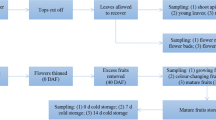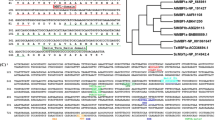Abstract
The heat shock response (HSR) is a conserved mechanism by which transcripts of heat shock protein (hsp) genes accumulate following mobilization of heat shock transcription factors (HSFs) in response to thermal stress. Studies in animals identified the heat shock factor-binding protein1 (HSBP1) that interacts with heat shock transcription factor1 (HSF1) during heat shock attenuation; overexpression analyses revealed that the coiled-coil protein HSBP1 functions as a negative regulator of the HSR. Zea mays contains two HSBP paralogs, EMP2 and HSBP2, which exhibit differential accumulation during the HSR and plant development. Embryo-lethal recessive emp2 mutations revealed that EMP2 is required for the down-regulation of hsp transcription during embryogenesis, whereas accumulation of HSBP2 is induced in seedlings following heat shock. Notwithstanding, no interaction has yet been demonstrated between a plant HSBP and a plant HSF. In this report 22 maize HSF isoforms are identified comprising three structural classes: HSF-A, HSF-B and HSF-C. Phylogenetic analysis of Arabidopsis, maize and rice HSFs reveals that at least nine ancestral HSF isoforms were present prior to the separation of monocot and eudicots, followed by differential amplification of HSF members in these lineages. Yeast two-hybrid analyses show that EMP2 and HSBP2 interact non-redundantly with specific HSF-A isoforms. Site-specific mutagenesis of HSBP2 reveals that interactions between hydrophobic residues within the coiled coil are required for HSF::HSBP2 binding; domain swapping demonstrate that the isoform specificity of HSF::HSBP interaction is conferred by residues outside of the coiled coil. These data suggest that the non-redundant functions of the maize HSBPs may be explained, at least in part, by the specificity of HSBP::HSF interactions during plant development.






Similar content being viewed by others
Abbreviations
- HSR:
-
Heat shock response
- HSF:
-
Heat shock factor
- HSBP:
-
Heat shock factor-binding protein
- HSP:
-
Heat shock protein
- EMP2:
-
Empty pericarp2
- HSBP2:
-
Heat shock-binding protein2
References
Baniwal SK, Bharti K, Chan KY, Fauth M, Ganguli A, Kotak S, Mishra SK, Nover L, Port M, Scharf KD, Tripp J, Weber C, Zielinski D, Von Koskull-Doring P (2004) Heat stress response in plants: a complex game with chaperones and more than twenty heat stress transcription factors. J Biosci 29:471–487
Bharti K, Von Koskull-Doring P, Bharti S, Kumar P, Tintschl-Korbitzer A,Treuter E, Nover L (2004) Tomato heat stress transcription factor HsfB1 represents a novel type of general transcription coactivator with a histone-like motif interacting with the plant CREB binding protein ortholog HAC1. Plant Cell 16(6):1521–1535
Boscheinen O, Lyck R, Queitsch C, Treuter E, Zimarino V, Scharf KD. (1997) Heat stress transcription factors from tomato can functionally replace HSF1 in the yeast Saccharomyces cerevisiae. Mol Gen Genet 255:322–331
Burkhard P, Stetefeld J, Strelkov SV (2001) Coiled-coils: a highly versatile protein folding motif. Trends Cell Biol 11:82–88
Busch W, Wunderlich M, Schoffl F (2005) Identification of novel heat shock factor-dependent genes and biochemical pathways in Arabidopsis thaliana. Plant J 41:1–14
Cotto JS, Morimoto RI (1999) Stress-induced activation of the heat-shock response: cell and molecular biology of heat-shock factors. Biochem Soc Symp 64:105–118
Cotto JS, Kline M, Morimoto RI (1996) Activation of heat shock factor 1 DNA binding precedes stress-induced serine phosphorylation. Evidence for a multistep pathway of regulation. J Biol Chem 271:3355–3358
Crick FCH (1953) The packing of a-helices: simple coiled-coils. Acta Crystallogr 6:689–697
Czarnecka-Verner E, Yuan CX, Scharf KD, Englich G, Gurley WB (2000) Plants contain a novel multi-member class of heat shock factors without transcriptional activator potential. Plant Mol Biol 43:459–471
Fu S, Meeley R, Scanlon MJ (2002) Empty pericarp2 encodes a negative regulator of the heat shock response and is required for maize embryogenesis. Plant Cell 14:3119–3132
Fu S, Scanlon MJ (2004) Clonal mosaic analysis of EMPTY PERICARP2 reveals nonredundant functions of the duplicated heat shock factor binding proteins during maize shoot development. Genetics 167:1381–1394
Gagliardi D, Breton C, Chaboud A, Vergne P, Dumas C (1995) Expression of heat shock factor and heat shock protein 70 genes during maize pollen development. Plant Mol Biol 4:841–856
Jeanmougin F, Thompson JD, Gouy M, Higgins DG, Gibson TJ (1998) Multiple sequence alignment with Clustal X. Trends Biochem Sci 23:403–405
Ke SH, Madison EL (1997) Rapid and efficient site-directed mutagenesis by single-tube ‘megaprimer’ PCR method. Nucleic Acids Res 15:3371–3372
Lindquist S (1986) The heat-shock response. Annu Rev Biochem 55:1151–1191
Lohmann C, Eggers-Schumacher G, Wunderlich M, Schoffl F (2004) Two different heat shock transcription factors regulate immediate early expression of stress genes in Arabidopsis. Mol Genet Genomics 271:11–21
Lupas A, Van Dyke M, Stock J (1991) Predicting coiled-coils from protein sequences. Science 252:1162–1164
Mishra SK, Tripp J, Winkelhaus S, Tschiersch B, Theres K, Nover L, Scharf KD (2002) In the complex family of heat stress transcription factors, HsfA1 has a unique role as master regulator of thermotolerance in tomato. Genes Dev 16(12):1555–1567
Mosser DD, Duchaine J, Massie B (1993) The DNA-binding activity of the heat shock transcription factor is regulated in vivo by hsp70. Mol Cell Biol 13:5427–5438
Moll JR, Olive M, Vinson C (2000) Attractive interhelical electrostatic interactions in the proline- and acidic-rich region (PAR) leucine zipper subfamily preclude heterodimerization with other basic leucine zipper subfamilies. J Biol Chem 275:34826–34832
Nover L, Bharti K, Doring P, Mishra SK, Ganguli A, Scharf KD (2001) Arabidopsis and the heat stress transcription factor world: how many heat stress transcription factors do we need? Cell Stress Chaperones 6:177–189
Peteranderl R, Rabenstein M, Shin YK, Liu CW, Wemmer DE, King DS, Nelson HC (1999) Biochemical and biophysical characterization of the trimerization domain from the heat shock transcription factor. Biochemistry 38(12):3559–3569
Peteranderl R, Nelson HC (1992)Trimerization of the heat shock transcription factor by a triple-stranded alpha-helical coiled-coil. Biochemistry 31(48):12272–12276
Port M, Tripp J, Zielinski D, Weber C, Heerklotz D, Winkelhaus S, Bublak D, Scharf KD (2004) Role of Hsp17.4-CII as coregulator and cytoplasmic retention factor of tomato heat stress transcription factor HsfA2. Plant Physiol 135:1457–1470
Precht H, Christophersen J, Hensel H, Larcher W (1973) Temperature and life. Springer, Berlin Heidelberg New York
Rabindran SK, Haroun RI, Clos J, Wisniewski J, Wu C (1993) Regulation of heat shock factor trimer formation: role of a conserved leucine zipper. Science 259:230–234
Ritossa F (1962) A new puffing pattern induced by heat shock and DNC in Drisophila. Experimenta 18:571–573
Sambrook J, Russell DW (2000) Molecular cloning: a laboratory manual. 3rd edn. Cold Spring Harbor Laboratory, New York
Sarge KD, Murphy SP, Morimoto RI (1993) Activation of heat shock gene transcription by heat shock factor1 involves oligomerization, acquisition of DNA-binding activity, and nuclear localization and can occur in the absence of stress. Mol Cell Biol 13:1392–1407
Satyal SH, Chen D, Fox SG, Kramer JM, Morimoto RI (1998) Negative regulation of the heat shock transcriptional response by HSBP1. Genes Dev 12:1962–1974
Scanlon MJ, Stinard PS, James MG, Myers AM, Robertson DS (1994) Genetic analysis of 63 mutations affecting maize kernel development isolated from Mutator stocks. Genetics 136:281–294
Scanlon MJ, Schneeberger RG, Myers AM, Freeling M (1997) The empty pericarp-2 gene is required for leaf development during maize embryogenesis. Plant J 12:901–909
Scharf KD, Heider H, Hohfeld I, Lyck R, Schmidt E, Nover L (1998) The tomato Hsf system: HsfA2 needs interaction with HsfA1 for efficient nuclear import and may be localized in cytoplasmic heat stress granules. Mol Cell Biol 18:2240–2251
Shi Y, Mosser DD, Morimoto RI (1998) Molecular chaperones as HSF1-specific transcriptional repressors. Genes Dev 12:654–666
Sorger PK, Nelson HC (1989) Trimerization of a yeast transcriptional activator via a coiled-coil motif. Cell 59:807–813
Spek EJ, Bui AH, Lu M, Kallenbach NR (1998) Surface salt bridges stabilize the GCN4 leucine zipper. Protein Sci 7:2431–2437
Thompson JD, Higgins DG, Gibson TJ (1994) CLUSTAL W: improving the sensitivity of progressive multiple sequence alignment through sequence weighting, positions-specific gap penalties and weight matrix choice. Nucleic Acids Res 22:4673–4680
Thompson KS, Vinson CR, Freire E (1993) Thermodynamic characterization of the structural stability of the coiled-coil region of the bZIP transcription factor GCN4. Biochemistry 32:5491–5496
Wolf E, Kim PS, Berger B (1997) MultiCoil: a program for predicting two- and three-stranded coiled-coils. Protein Sci 6:1179–1189
Wu C (1995) Heat shock transcription factors: structure and regulation. Ann Rev Cell Dev Biol 11:441–469
Wunderlich M, Werr W, Schoffl F (2003) Generation of dominant-negative effects on the heat shock response in Arabidopsis thaliana by transgenic expression of a chimaeric HSF1 protein fusion construct. Plant J 35:442–451
Yamanouchi U, Yano M, Lin H, Ashikari M, Yamada K. (2002) A rice spotted leaf gene, Spl7, encodes a heat stress transcription factor protein. Proc Natl Acad Sci USA 99:7530–7535
Yu YB (2002) Coiled-coils: stability, specificity, and drug delivery potential. Adv Drug Deliv Rev 54:1113–1129
Acknowledgements
The authors wish to thank Mark Osterlund for technical advice in yeast genetics. This research was supported by USDA-CREES-NRICGP grant 01-01600 to MS.
Author information
Authors and Affiliations
Corresponding author
Electronic supplementary material
Rights and permissions
About this article
Cite this article
Fu, S., Rogowsky, P., Nover, L. et al. The maize heat shock factor-binding protein paralogs EMP2 and HSBP2 interact non-redundantly with specific heat shock factors. Planta 224, 42–52 (2006). https://doi.org/10.1007/s00425-005-0191-y
Received:
Accepted:
Published:
Issue Date:
DOI: https://doi.org/10.1007/s00425-005-0191-y




